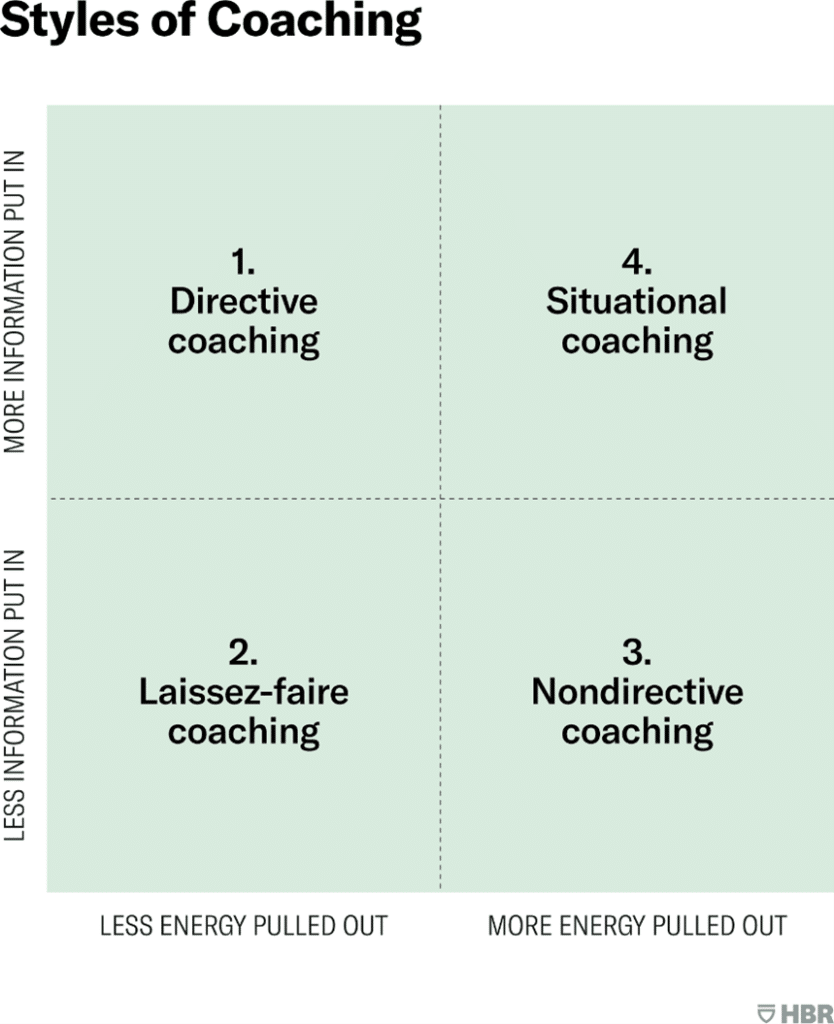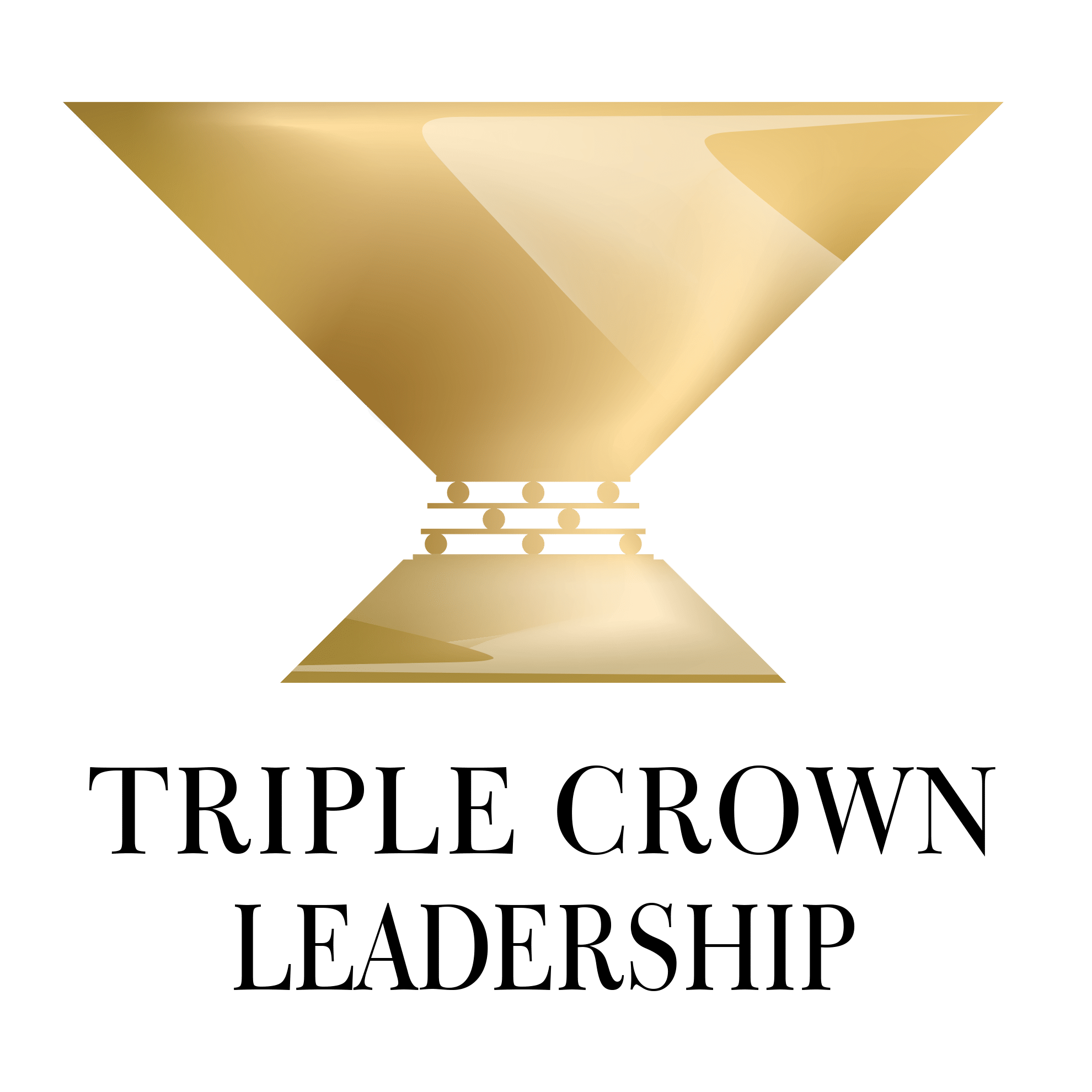Article Summary:
A coaching leadership style is on the rise to help organizations be more effective with today’s workers and our current challenges.
++++++
Coaching leaders provide guidance and support to people to help them achieve their goals and reach their full potential. They invest their time and energy into developing people. Coaching leaders identify people’s strengths and weaknesses and help them grow, improve, and succeed.
What Is Coaching?
Good coaching involves building trust, communicating effectively, encouraging, collaborating, developing self-awareness, showing compassion, asking questions, providing constructive feedback, giving stretch assignments, offering highly personalized support, and more.
It helps people identify issues and work through them with the support of a trusted guide. A coach functions as a partner, walking alongside coachees with empathy and support, helping to develop their capacities. The best coaches elicit the courage, inner wisdom, and sense of possibility among the people they work with, inviting them to integrate their head and heart in their work.
Coaching involves asking questions like the following:
What are you trying to achieve, now and in the future?
How do your goals fit with the organization’s goals?
How do you plan to make this happen?
How are things going?
What’s getting in your way?
How can we help?
“The leader of the future asks: the leader of the past tells.”
-Peter Drucker, legendary management expert and consultant
Great coaches connect with the hearts and souls of their people. They build trust. Great coaches earn respect. They succeed in getting their people to believe in themselves as well as their coach, team, and organization.
Coaching Leadership
Supervisors can apply this coaching approach to their leadership. When coaching, a good leader doesn’t act like a controlling boss telling everybody what to do. Most people don’t want to be bossed, managed, controlled, or told what to do all the time.
On the other hand, most people are willing and even happy to be guided, taught, and inspired. They value having someone with knowledge, skill, or experience share things that are useful in their work or that help them grow. Most people are happy to receive coaching from someone whom they respect and trust and who cares about them.

Leadership Derailers Assessment
Take this assessment to identify what’s inhibiting your leadership effectiveness. It will help you develop self-awareness and identify ways to improve your leadership.
Coaching vs. Mentoring
A coaching leader is not a mentor. A mentor shares their knowledge, skills, or experience to help another person grow and develop. In many organizational mentoring programs, a senior or more experienced person (mentor) acts as an advisor to a more junior colleague.
Coaching Leadership on the Rise
Coaching leadership is on the rise in part because it suits our current context so well. We’re now in the digital age, with rapid technological change and increasing volatility and complexity. To survive and thrive, today’s institutions must become adaptable learning organizations. Enter coaching.
“Twenty-first-century managers simply don’t (and can’t!) have all the right answers. To cope with this new reality, companies are moving away from traditional command-and-control practices…. The role of the manager, in short, is becoming that of a coach. This is a dramatic and fundamental shift.”
–Herminia Ibarra and Anne Scoular, “The Leader as Coach,”
Harvard Business Review, November-December 2019

Educators have long recognized that one of the most effective ways to help people grow and develop is experiential. After a certain amount of technical training by conventional means, most people learn best by doing something, making mistakes, having successes, and learning from their experiences.
How Coaching Leadership Works
The coaching leader listens, observes, asks open-ended questions, and encourages people to develop their own ideas and solutions and experiment with new approaches. The idea is helping people reach their full potential.
Rather than telling people what to do, coaching leaders empower people by leveraging their natural strengths and providing them with appropriate challenges. They help people learn through real-life experiences and tough challenges.
In short, coaching leaders:
- ask questions instead of dispensing orders and answers
- support workers instead of judging them
- facilitate the development of their people instead of treating them as dispensable
- help people discover answers themselves
“The growth and development of people is the highest calling of leadership.”
-Harvey S. Firestone
With such an approach, coaching leaders establish a culture that is inclusive, team-oriented, and fixed on goals or visions that resonate with and inspire the team members. What’s more, they set standards for behavior that people must uphold.
“An effective manager-as-coach asks questions instead of providing answers, supports employees instead of judging them, and facilitates their development instead of dictating what has to be done.”
-Herminia Ibarra and Anne Scoular, “The Leader as Coach”
In their Harvard Business Review article, “The Leader as Coach,” Herminia Ibarra and Anne Scoular distinguish between four different styles of coaching, depending on the situation:
- directive coaching: telling junior colleagues what to do, based on knowledge and experience (can include mentoring)
- laissez-faire coaching: the manager doesn’t need to intervene much at all since workers are proceeding well with their work
- nondirective coaching: focused on asking questions, listening, withholding judgment, and eliciting people’s creativity, insights, and wisdom so they can learn to resolve problems and address challenges on their own
- situational coaching: striking a balance between directive and nondirective coaching styles, depending on the people and their current context and needs

Across these coaching styles, there are different levels not only of information put in by managers but also of energy pulled out by workers. Workers tend to gain much more energy from coaching via the nondirective and situational coaching styles.

Personal Values Exercise
Complete this exercise to identify your personal values. It will help you develop self-awareness, including clarity about what’s most important to you in life and work, and serve as a safe harbor for you to return to when things are tough.
The Benefits of Coaching Leadership
A coaching leadership style has many benefits, not only for the coachee and leader but also for the organization. For example, it:
- gives workers room to think for themselves
- shows workers that they have the trust of their managers
- provides opportunities for people to develop their knowledge and enhance their skills in challenging assignments
- helps instill more buy-in for proposed solutions, since the workers led the way in developing them
- connects what workers want with the organization’s purpose, values, vision, and goals
- helps workers develop greater self-awareness and get unstuck
- boosts worker motivation, fulfillment, and impact
- boosts the confidence of workers
- develops the long-term capabilities of people
- deepens relationships among colleagues
- creates a positive work environment
- helps build a high-performance organizational culture
- develops more leaders
“Grow a leader—grow the organization.”
-John Maxwell, Developing the Leaders Around You
According to research, coaching conversations can significantly increase the effectiveness of training programs.* Also, the Travelers Companies discovered that their workers are much more engaged—and demonstrate better capacity, commitment, and efficiency—when their leaders are effective coaches.**
Exceptions to This Model
A coaching leadership approach isn’t appropriate for all circumstances. For example:
- When supervising novice or untrained workers, leaders should provide detailed detailed instructions on what to do until the workers develop baseline competencies.
- When working in extreme circumstances in which deviations could cause significant harm, leaders must be directive and crystal clear in giving instructions and parameters.
- When in a crisis or emergency, supervisors must flex to the hard edge of leadership (what we call “steel leadership”), including using power, showing toughness, demonstrating decisiveness, enforcing decisions, ensuring execution, and instilling discipline and accountability.
- When workers are not receptive to coaching (e.g., seeking autonomy to do things their way or clearer instructions on what to do), then supervisors should generally oblige.
The coaching leadership style works best with motivated workers hungry for development and growth.

Alignment Scorecard
When organizations aren’t aligned, it can reduce performance dramatically and cause frustration and dysfunction. With this Alignment Scorecard, you can assess your organization’s level of alignment and make plans for improving it.
The Challenges of Coaching Leadership
A coaching leadership approach comes with certain challenges. For example, it can be time-consuming, especially at the outset. It takes patience and a willingness to let people discover their own ways. That entails a learning curve, with time and patience to let things unfold.
Coaching leadership is also difficult to pull off effectively in certain organizational cultures, such as ones with a preference for command-and-control management and a focus on results only, without an appreciation for the experience of workers in their attempts to achieve those results.
It can also be challenging to do well. Managers often overestimate their ability to coach effectively, as shown in comparing manager self-ratings versus ratings they receive from their colleagues on their actual coaching behaviors.
And when coaching gets hard, with no clear answers to complex questions, managers tend to fall back into old patterns of relying on their knowledge and authority, in the process lowering worker motivation and inhibiting development. By contrast, coaching leadership hangs in there despite the uncertainty, trusts the process, and lets the coachee do the work (or at the very least co-creating solutions).
Building Organizational Capacity for Coaching Leadership
Coaching leadership isn’t only an individual phenomenon. In today’s dynamic context, we must build organizational capacity for it. How?
First, we must connect this leadership style to the organization’s “colors”—its shared purpose, values, and vision—and culture so that people understand the big picture and see that things cohere.
Second, the CEO and other senior executives must model this coaching leadership style, as Microsoft Satya Nadella has done so masterfully in recent years. He evangelized the need to shift from a company full of “know-it-alls” to one full of “learn-it-alls” with a growth mindset. In the process, he modeled asking questions, deep listening, and showing support, vulnerability, and psychological safety.
Third, we must develop coaching capabilities among managers throughout the organization via training, workshops, online courses, and, yes, coaching. This includes developing their self-awareness, empathy, emotional and social intelligence, communication skills, and situational intelligence (e.g., seeing issues from multiple perspectives and at different levels, including individual, team, organizational, and market).
Finally, we must build coaching into the rhythm of daily work, moving away from a mindset of development only addressed in annual reviews, instead building learning and development into ongoing meetings, informal conversations, and other ongoing check-ins. Communication and feedback must flow fast and often.
“…with full institutional support, they need to reinvent themselves as coaches
whose job it is to draw energy, creativity, and learning out of the people with whom they work.”
-Herminia Ibarra and Anne Scoular, “The Leader as Coach”
Conclusion
The coaching leadership style is an excellent way to build and unleash the potential of people and achieve extraordinary results. More and more, leaders are taking a coaching approach to help their workers discover new and better ways to accomplish their work.
Reflection Questions
- Does the coaching leadership model resonate with you?
- To what extent is it used in your organization?
- Are you willing to coach your colleagues?
- How will you gauge the effectiveness of this approach—and how you can improve it going forward?
Tools for You
- Leadership Derailers Assessment to help you identify what’s inhibiting your leadership effectiveness
- Personal Values Exercise to help you determine and clarify what’s most important to you
- Alignment Scorecard to help you assess your organization’s level of alignment

Leadership Derailers Assessment
Take this assessment to identify what’s inhibiting your leadership effectiveness. It will help you develop self-awareness and identify ways to improve your leadership.
Related Articles & Resources
- “The Hazards of Advice“
- “Don’t Give Advice. Do This Instead“
- “How Advice Gets Ruined by Cognitive Biases“
- “Great Leaders Prioritize Learning–Why and How“
- Bill George, “Leaders as Coaches” short video
- Herminia Ibarra and Anne Scoular, “The Leader as Coach,” Harvard Business Review, November-December 2019
- Bill George and Zach Clayton, “Successful Leaders Are Great Coaches,” Harvard Business Review, October 2022
- “What Are Your Strengths–And How Can You Use Them More?”
- “A CEO Reflects on Using Different Strengths in Different Phases of Life“
Postscript: Quotations on the Leader as Coach
- “Coaching will become the model for leaders in the future.” -Warren Bennis, leadership expert
- “Coaching is one of the most effective leadership styles that can transform, empower and unlock people’s potential. Ask more, give advice less, and elevate your impact forever.” -Farshad Asl, author and leadership expert
- “Coaching is designed to be the leadership approach of the 21st century.” – James Belasco, leadership and business author
- “Coaching is unlocking a person’s potential to maximize their own performance. It is helping them to learn rather than teaching them.” -Timothy Gallwey, called “the father of modern coaching” and author, The Inner Game
- “Coaching is the most important servant-leadership element in helping people accomplish their goals.” -Bill Hybels, founding and former senior pastor of Willow Creek Community Church
- “People don’t mind being challenged to do better if they know the request is coming from a caring heart.” -Ken Blanchard, leadership author
- “There are three questions that every follower is asking about their leader. Can you help me? Do you care about me? Can I trust you?” -John Maxwell, leadership author
- “A great leader has the ability to instill within his people confidence in themselves.” -John Maxwell, Developing the Leaders Around You
- “The greatness of a coach can be measured by their ability to help someone grow to a point of no longer needing them.” -Ron Carucci, business executive and author
- “Coaching is helping someone to have the life they want while becoming more of themselves.” -Toku McCree, executive coach and founder of Samurai Coaching Dojo
- “A coach is someone who can give correction without causing resentment.” -John Wooden, legendary UCLA basketball coach
- “A coach is someone who tells you what you don’t want to hear, who has you see what you don’t want to see, so you can be who you have always known you could be.” -Tom Landry, NFL football coach
- “Each person holds so much power within themselves that needs to be let out. Sometimes they just need a little nudge, a little direction, a little support, a little coaching, and the greatest things can happen.” -Pete Carroll, NFL football coach
Appendix: Coaching Leadership in Context
The coaching leadership model resonates with several other prominent leadership frameworks, including our triple crown leadership framework, servant leadership (Robert Greenleaf), authentic leadership (Bill George), conscious leadership, trust-based leadership (Stephen M. R. Covey and Bob Whipple), and more.
In 1969, Ken Blanchard and Paul Hersey developed the situational leadership framework and then subsequently updated it, including the Situational Leadership II (SLII) model in their 2013 book, Leadership and the One Minute Manager. In that model, leadership includes both directive and supportive behaviors, depending on the competence and commitment of followers.
One of the four leadership styles in this model is the coaching style (S2), which they called “high directive” and “high supportive,” versus the other styles: delegating (low supportive and low directive), supporting (high supportive and low directive), and directing (high directive and low supportive). In SLII, the coaching style focuses both on achieving goals and on meeting the socioemotional needs of followers. It involves soliciting worker input and providing encouragement.
In their 2002 book, Primal Intelligence, Daniel Goleman, Richard Boyatzis, and Annie McKee identified coaching leadership as one of six primary leadership styles (along with visionary, affiliative, democratic, pacesetting, and commanding styles).
Sources:
* Paul Leone, “Take Your ROI to Level 6,” Training Industry Quarterly, Spring 2008.
** F. Colon and D. Clifford, “Measuring Enabling Others to Act: The Travelers Coaching Questionnaire,” 2015.

Triple Crown Leadership Newsletter
Join our community. Sign up now and get our monthly inspirations (new articles, announcements, opportunities, resources, and more). Welcome!
+++++++++++++++++++++++
Gregg Vanourek and Bob Vanourek are leadership practitioners, teachers, and award-winning authors (and son and father). They are co-authors of Triple Crown Leadership: Building Excellent, Ethical, and Enduring Organizations, a winner of the International Book Awards. Check out their Leadership Derailers Assessment or get their monthly newsletter. If you found value in this, please forward it to a friend. Every little bit helps!


